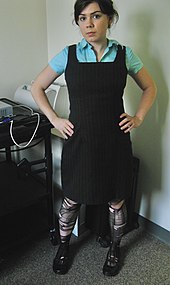

A jumper (in American English), jumper dress, or pinafore dress is a sleeveless, collarless dress intended to be worn over a blouse, shirt, T-shirt or sweater. Hemlines can be of different lengths and the type of collar and whether or not there is pleating are also variables in the design.
In British English, the term jumper describes what is called a sweater in American English. Also, in more formal British usage, a distinction is made between a pinafore dress and a pinafore. The latter, though a related garment, has an open back and is worn as an apron. In American English, pinafore always refers to an apron.
A sundress, like a jumper, is sleeveless and collarless; however, such articles are not worn over a blouse or sweater, and are of distinctly different cuts and fashions. The apron dress may be viewed as a special case of the jumper. If the design of the dress is directly inspired by an apron (having a bib in front and ties in the back, for example), the garment is typically described as an apron dress.
History
Jumpers for fall were described in The Fort Wayne Sentinel in 1906. The dresses were "imported from Paris" and featured "original lines."
Jumpers in the United States were part of the sportswear collections of Jean Patou, Coco Chanel and Paul Poiret. Suzanne Lenglen wore Patou's jumper design in the 1920s. The dresses, worn over blouses, became popular during the decade of the 1920s. Jumpers were often worn in the summer and made out of various types of fabrics.
Jumpers were touted as an "American" and a "sports fashion" in 1930 by the Pittsburgh Press. The dresses were also praised for allowing women to create color combinations through the choice of blouse worn underneath.
Jumpers were again popularized in 1953, when Hubert de Givenchy promoted his own jumper. Jumpers, now considered a "classic" look, were considered "suitable to all ages."
See also
- Gymslip – a British pinafore dress worn as athletic wear or school uniform
- Kirtle – a medieval garment of similar function
- Romper suit – combination of shorts and shirt
- Sarafan – a Russian traditional jumper dress
References
Citations
- McKean, Erin (2013). The Hundred Dresses: The Most Iconic Styles of Our Time. Bloomsbury. ISBN 978-1408190500.
the jumper dress (known in the UK as a Pinafore dress) is a sleeveless dress intended to be worn over a blouse, shirt, turtleneck, jersey, or sweater. A Jumper may have a bodice with a completely closed back, or it may have a bib front, like a pair of overalls.
- "Hints for the Home Dressmaker". Chicago Tribune. 1906-11-11. p. 83. Retrieved 2018-02-09 – via Newspapers.com.
- Ambrose, Gavin; Paul Harris (2007). The Visual Dictionary of Fashion Design 2940373612. p. 190.
Also called a pinny, a pinafore dress was intended to be worn over a top or blouse, but the name refers to any sleeveless dress that fastens behind. The name originates from the aprons that were pinned to the front of a dress.
- Jumper, definition in Collins American Dictionary
- "Pinafore" Oxford Dictionaries
- ^ Marie, Jen (2 June 2015). "A Brief History of the Jumper". Bustle. Retrieved 2018-02-09.
- Picken 1957, p. 101.
- ^ "A New Model 'Jumper' Dress for Fall". The Fort Wayne Sentinel. 1906-09-10. p. 6. Retrieved 2018-02-09 – via Newspapers.com.
- Howell, Frances S.; Costilow, Christopher T. (2010). History of American Dress from the 15th and 16th Century Through 1965. Chris Costilow. p. 147. ISBN 9781450547383.
- Bottomley, Julia (1925-07-10). "Jumper Dress is Popular; In the Ultra Smart Mode". West Schuylkill Herald. p. 3. Retrieved 2018-02-09 – via Newspapers.com.
- ^ Parrish, Amos (1930-10-14). "What's In Fashion: The Youthful Jumper Dress". The Pittsburgh Press. p. 26. Retrieved 2018-02-09 – via Newspapers.com.
- Snodgrass, Mary Ellen (2015). World Clothing and Fashion: An Encyclopedia of History, Culture, and Social Influence. Routledge. p. 75. ISBN 9781317451679.
- Blair, Beth (1957-03-07). "Classic Jumper Dress Is Suitable to All Ages". Courier-Post. p. 22. Retrieved 2018-02-09 – via Newspapers.com.
General and cited sources
- Picken, Mary Brooks (1957). The Fashion Dictionary: Fabric, Sewing, and Dress as Expressed in the Language of Fashion. New York: Funk & Wagnalls Company. OCLC 959053572.
External links
| Clothing | |||||||||
|---|---|---|---|---|---|---|---|---|---|
| Headwear | |||||||||
| Neckwear | |||||||||
| Underwear and lingerie |
| ||||||||
| Tops | |||||||||
| Bottoms |
| ||||||||
| Full-Body Wear |
| ||||||||
| Coats and outerwear |
| ||||||||
| Nightwear | |||||||||
| Swimwear | |||||||||
| Legwear | |||||||||
| Footwear | |||||||||
| Accessories |
| ||||||||
| Dress codes |
| ||||||||
| Related | |||||||||